Vendor management is the process of acquiring maximum benefits from IT contracts. With professional digital contract lifecycle management and sourcing expertise, digital vendor management can take supplier management to a higher level.
Digital transformation is crucial for the ongoing effectiveness of vendor management because the world is becoming increasingly digital. Businesses need to stay competitive by leveraging technology and IT services, which can be difficult without the right expertise in place.
With the pressure to succeed in today’s business world, many enterprises are outsourcing a wide range of IT services. This allows them to focus on their company’s essential functions. You can take a more comprehensive approach to vendor management when you bolster your IT ecosystem with tools such as digital procurement and sourcing contracts.
Reliable relationships with B2B vendors are crucial for the smooth running of any organization. Furthermore, it’s now common for companies to work with multiple vendors, each of which has its strengths, weaknesses, and needs.
So, building an effective process for procuring and managing vendors is essential. Vendor management software can often solve inefficient business processes and help businesses achieve total digital adoption.
Yet the implementation of vendor management systems is not always a priority. A recent Statista report noted that only 12% of global companies actively planned to revitalize their vendor management systems.
This article will explain why vendor management is worth investing time and money in. It will also define vendor management, how it can help save a company money, and how to implement a strategic process to ensure a great relationship with each vendor. Whether not a company goes through a digital transformation to deal with these issues, an efficient vendor management process is fundamental to sustained growth.
What Is IT Vendor Management?

The term “vendor management” refers to how companies procure, monitor, and evaluate vendors to help achieve their business objectives. In large companies, a separate team will deal with procurement, as it is one of the most important steps in the life cycle of a relationship with a vendor,
In practical terms, vendor management occurs with every interaction between a company and its vendors. That might include update meetings, informal conversations, and shared reports. However, good vendor management relies on acquiring robust vendor data. A vendor management system (or VMS) ensures businesses are making excellent decisions around vendors.
IT vendor management is a specialist area of vendor management. The vendor procurement and management process for digital services can be slightly different from general vendor management. Software and hardware capabilities are constantly changing, requiring specialist knowledge from vendor management staff. Furthermore, data around IT processes can be far more vulnerable than others.
As such, a global increase in IT outsourcing has led to more demands on IT vendor management. So although IT vendor management now has its own specialists, in many cases, the best practices within vendor management, in general, do apply to IT.
Benefits of an Agile IT Vendor Management Process

Businesses will implement a formal vendor management process to achieve one or more of the following aims:
- Improved vendor selection
- Cost savings
- Efficient vendor onboarding
- Reliable risk assessment systems
- Predict supply chain problems
- Improved ability to negotiate
- Better vendor relationships
Even with poor records of vendor information, a small business with superficial vendor relationships may be able to handle these areas. But as a company grows in scale and vendor contracts become more complex, it’s important to keep track of progress and create a vendor offboarding checklist.
The agile approach to project management can bring many benefits to a company. It’s well known that Agile management begins with a simple set of priorities, including:
- Regular face-to-face interactions between individuals
- Producing workable solutions on short timescales
- Collaborating closely with customers and other stakeholders
- Responding positively to change at any stage of a project
Agile working is more popular now than it has ever been. And in a world beset by radical changes, this makes sense: Agile makes organizations highly resilient and capable of swift changes.
Managing vendors with Agile will not always be simple, even in the best circumstances. The client and vendor must have closely aligned principles. Both sides must be ready for daily communication, regular negotiation, and iterative deliverables. Buy-in and commitment will be essential. If a vendor’s business model is not agile, then the partnership would need to take a different direction.
Vendor management software can be beneficial for Agile working environments. It will automatically keep tabs on key performance indicators and all vendor-related information.
The Challenges of IT Vendor Management System

One of the central aims of proper vendor management is reducing vendor-related risks. However, good VMS systems can have challenges and problems that need to be addressed from the outset.
Here are some examples of issues that may arise from vendor management systems:
- Staffing and personnel. Does the business have well-trained staff responsible for maintaining the vendor relationship? Without a solid vendor management team, you may run into problems.
- Executive investment. As with any digital system, a VMS for IT suppliers will struggle without management consistently supporting the package.
- Multiple vendors operate in different ways. Over time, good vendor management software will naturally help to standardize and streamline processes across the dozens of vendors in a business. But initially, how different vendors handle contracts, invoices, and compliance, can be a real mess.
- Balancing risks from multiple vendors. Even with a great vendor management process, risks will not go away. A VMS can help mitigate risks, but it will not make them disappear.
- Cost management. The price of running an effective VMS should help to ensure that your relationships work effectively. However, the prices of the right staff and software can be high. A complete evaluation before implementation can identify problems.
- Data security. Vendor management software is handy for consolidating and standardizing data. However, it’s important to remember that these systems make data vulnerable to attack. A survey by Statista showed that 50% of companies had seen increases in cyberattacks in 2021. As such, businesses that are serious about their vendor management system also need to be serious about protecting their data.
By keeping these areas in mind, the vendor management team will help to mitigate risks while continuing to meet company objectives.
It’s also worth remembering that the exact implementation of a vendor management system can be challenging. After all, a VMS will aim to solve problems that may have been embedded in a business for a long time.
Before the roll-out of a VMS, a business may have poor control over vendor data, no consistent understanding of vendor risks, and erratic relationship management with suppliers. A vendor management team must carefully plan its digital adoption strategy for companies like this.
The Six-Stage Vendor Management Process
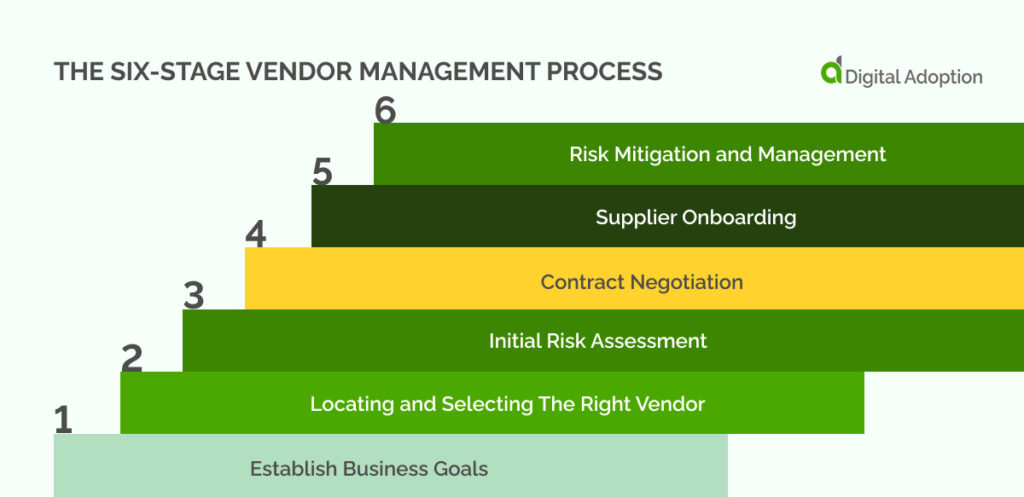
An effective vendor management process ensures that every stage of the vendor relationship is handled carefully. Although a poor management process can cost a company money, there are opportunities for efficiencies and savings at every step of the journey. From initial procurement to offboarding, an active approach with the right vendors can help directly to fulfill business objectives.
1. Establish Business Goals
The first step of vendor management is understanding the current needs and aims of the business. This step underpins every other step in the process. Vendor management is far easier for companies with an apparent core mission.
In this step, the team will eventually decide what solution they are looking for. That might be a new cloud ERP, an outsourced helpdesk, or a new supplier of hand soap for the bathrooms.
But this step is also a time to remember the business’s core purpose. Is it to deliver excellent value retail products, best-in-field digital solutions, or to ensure a harmonious workplace? If a company knows what goals they are addressing in a particular project, all the specifics will be easier to decide.
2. Locating and Selecting The Right Vendor
Some niche services are so specialized that there will be very few vendors to choose between.
However, a business will have many suitable vendors in most areas.
A project with clear business goals will find it easy to determine vendor selection criteria. From there, the project team can undertake market research, make a shortlist of vendors who meet their needs and request proposals from those that seem most appropriate.
For large projects or searches for the most critical vendors, it may not be easy to see which is the most appropriate candidate. Evaluating proposals on a points system can often bring clarity to the process.
This step will function best when the business goals are clear.
3. Initial Risk Assessment
Having made a choice, it’s time to subject the selected vendors to a full risk assessment.
Some aspects of the assessment will be outside the selected vendor’s control. Problems like price instability, supply chain disruption, and inaccurate market forecasts may have a similar impact on all players in a particular field. A vendor can still explain what they are doing to control any problems in their sphere of work.
Other parts of the assessment will address the project and the vendor. Have they performed adequately in the past? Is their sourcing of labor and materials ethical? Could there be problems with overspending?
In this complex area, it’s possible to work with a risk mitigation consultant to understand how to minimize these problems. This step may be costly, but it increases the chance of a positive working relationship between a vendor and a customer.
4. Contract Negotiation
Although contract negotiation will have a noticeable impact on the project’s costs, this step may still change the nature of the service provided by the vendor. Negotiation is all about giving and taking. Customers who already understand their business goals will be able to adapt to the needs of the vendor.
Negotiation is a specialist skill. It doesn’t come naturally, although it can be learned. For negotiators, skills in empathy, clear communication, and rapport-building are more important than sticking to a hard line.
Both sides have already invested a lot of resources in the process. So it’s in everyone’s interests to work things out for the benefit of both parties.
5. Supplier Onboarding
Onboarding for vendors is an essential administrative procedure. During onboarding, the client company will receive full information about the supplier. Depending on the industry, this may include insurance certificates, bank account details, compliance information, and clear contacts.
It’s common to leave this information out of the tender process. However, if a supplier can’t provide complete documentation at this stage, they may lose the contract.
Businesses should expect the supplier to be helpful and considerate. However, just because they are struggling to get their data all lined up doesn’t mean that they are necessarily awful to deal with
An online vendor portal can be a valuable way of collecting this data. It is automated, cost-effective, and more reliable than sending information by mail, email, or fax.
6. Risk Mitigation and Management
Once the vendor is on board, the risk assessment will operate more continually. As the relationship develops, the risks associated with the vendor will change. A continual understanding of potential problems needs to be sustained.
How can agile working change this process?
An Agile mentality won’t work with every vendor procurement moment. If a business is working together for specific outcomes, on a strict timetable, or under the watchful eyes of industry regulation, the adaptability of agile thinking could cause problems.
But some vendor relationships will be improved through Agile practices.
An Agile procurement process allows business objectives to change, even while a vendor search is underway. And once the right vendor has been chosen, an agile approach would place less emphasis on a comprehensive contract at the outset of your relationship. Both sides must understand that needs will change and that the vendor and customer will find ways to communicate those needs.
Agile can be a way to secure positive long-term vendor relationships – but it is not the only way.
The Vendor Life Cycle
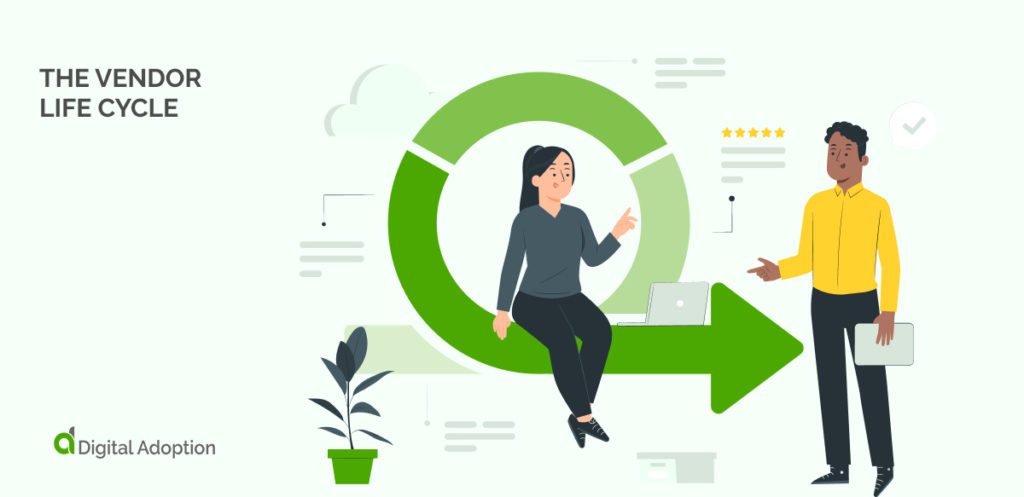
For large companies, vendor relationships can often go on for an extended period. Once a crucial vendor is embedded in a business, no one wants to change without good reason. But the ongoing importance of the relationship means more to come.
The procurement team evaluates vendor performance and ensures their contractual obligations are met. A business’s vendor management framework is equally important at the end as it is at the beginning.
IT Vendor Management vs. IT Vendor Procurement
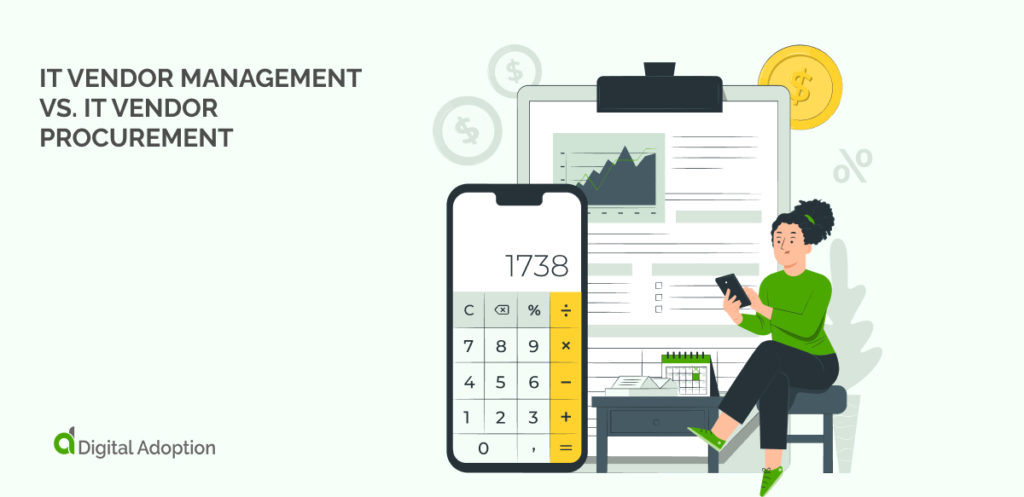
Vendor management and vendor procurement seem similar. They share the goal of controlling costs to fulfill business objectives. However, they are involved with different aspects of the life cycle of a vendor relationship.
A procurement team focuses on all the tasks around vendor selection and onboarding. Procurement takes the time to review all the potential vendors that may do business with the company, seek out the best possible price, and ensure that contracts are favorable to the business in the long term.
A vendor management team will take a much broader view. They are not only interested in securing the cheapest possible price. They are much more interested in managing all the risks involved through ongoing risk reporting.
The Importance of IT Vendor Relationship Management

Vendor relationship management puts control in the hands of the purchasing company. The process assumes that vendors are keen to offer their services and will work effectively to ensure productive outcomes.
The client’s control over the relationship is especially important for IT vendor management. The client may need a series of complex integrations that could involve major risks around supply chain disruption, user experience, and data security. Bringing all of that information into one place is vital.
10 Steps To Building A Strategic IT Vendor Management Process
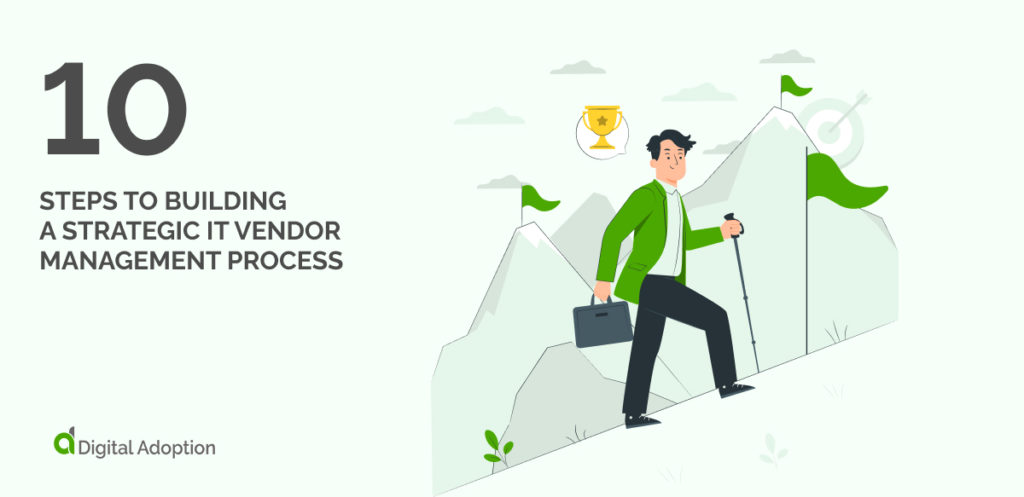
Improving a company’s overall vendor management takes serious time and effort. It will work much better if the process is strategic – underpinned by long-term goals.
Gartner has enhanced evaluation criteria for IT vendor selection. Achieving high marks in the evaluation criteria will improve a company’s chances of winning a deal.
IT vendor selection is important for any company looking to stay competitive in the fast-evolving tech landscape. In recent years, Gartner has significantly enhanced the criteria used to evaluate vendors and assign them ranking scores in its Magic Quadrant report.
This enhanced evaluation process is designed to help companies make more informed decisions when choosing a vendor for their IT needs. It considers factors like the vendor’s market share, competitive positioning, and product quality.
To achieve high ranks in Gartner’s evaluation criteria, vendors must demonstrate a robust product roadmap and commitment to innovation. They must also provide reliable customer support and maintain a solid reputation in the industry.
- Build A Vendor Management Strategy
Strategic vendor management takes active control of the full process. With a good strategy, a vendor manager can look at a vendor’s overall contribution to the company.
Whereas procurement teams mainly exist to control costs, a practice of strategic vendor management will comprehensively assess quality and reliability. A good vendor management strategy will consider a potential vendor’s full-service package.
Some organizations invest in a Vendor Management Office (a VMO) to ensure that their strategy is effective. VMOs are especially useful for managing complex IT relationships.
- Determine Criteria For Selecting The Right Vendor
The criteria for assessing a vendor will vary, but a formalized approach will ensure that vendor selection can occur quickly.
One simple (but effective) model for vendor evaluation is the ’10 Cs’ model produced by Roy Carter. The 10 Cs remind companies to consider financial information alongside the more comprehensive value a vendor may bring.
- Source Your Vendors

For niche IT services, even shortlisting appropriate vendors can be difficult. A company that does not understand the market well may employ an IT consultant to ensure they have the most up-to-date market knowledge.
- Prioritize and Compartmentalize Your Vendors
Vendor segmentation helps to assess vendor performance against the most relevant criteria. Some critical vendors will be a vital part of a company’s growth, making them strategic partners.
Other suppliers will be less crucial but difficult to change. And another group of vendors will be transactional, providing necessary goods and services that would nonetheless be replaceable.
The expectations and risks around each of these groups should be different. Strategic vendors are essential for their overall contribution to the business (not just price). However, this may be the main criteria that would apply to transactional vendors.
- Assess Contractual Obligations
Vendor contract management will change according to the culture of the company. An Agile organization may focus more on short-term goals and outcomes. While more traditional methods will consider the needs for years to come. Either way, having a standardized contract for suppliers can make onboarding significantly easier.
- Prepare For Vendor Onboarding

As mentioned earlier in this article, a solid vendor portal is an excellent step toward effective onboarding, monitoring, and reporting on progress and development. Problems can still arise at this stage, so it is essential to sort them out as soon as possible.
- Nurture Vendor Relationships
There are plenty of ways a business can enhance its relationship with vendors. Even though the vendor management process often deals with large companies and impersonal transactions, taking a “personal touch” can go a long way.
This may involve check-in phone calls, thoughtful meetings, and corporate gifting. Vendor relationship management is an integral part of the overall strategy.
- Assess Vendor Performance Routinely
A positive relationship benefits both vendor and client.
However, it’s still necessary to keep a close eye on the performance of each vendor. To do so, effective and reliable data tracking is a crucial tool. With real-time data monitoring, it’s then possible to track vendor performance over time: both here and now, at quarterly intervals, and annually.
If a vendor falls short on its key performance indicators, it’s essential to take action as soon as possible.
- Undertake Vendor Risk Assessments
With a vendor comfortably on board, it may be easy to forget the risks that may still emerge from the relationship. However, the risk management process must constantly assess the success and dangers of an IT vendor’s contribution to the business.
A 2022 Gartner report suggested that perceived and actual risks differed. While 22% of companies experienced problems with compliance (the most common risk), only 10% believed it to be the most significant anticipated risk. Vendor management professionals know the real dangers and learn how to tackle them.
- Learn From Previous Experience
Even the best vendor management processes will never be perfect. With all the expertise and experience, the world is constantly creating new problems for a stable supply chain.
Best Practices For Effective Vendor Management
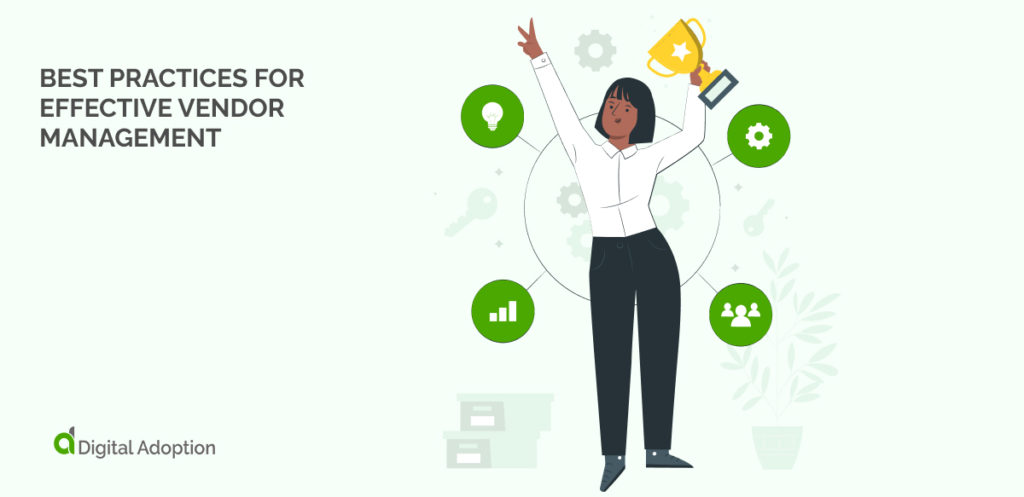
A new vendor management strategy can accelerate innovation, enhance organizational resilience, cut costs, reduce managers’ workloads, and more. The three-step process to digital transformation in vendor management is crucial for a working, cross-functional vendor management approach. The benefits of good vendor management will be measured over years of success.
Using a software solution is one of the simplest ways to ensure vendor management best practices across an organization. With well-trained staff and management buy-in, vendor management can be an excellent opportunity to showcase the power of digital transformation to a company.
A central reference point for all information makes it far easier to manage risks and secure data.
Vendor Management Helps to Achieve Business Goals

Vendor Management is a niche area of business expertise. Most of the complex labor goes on behind the scenes, away from end-users eyes.
But the goals of vendor management are fundamentally simple: making the most informed business decisions to help produce high levels of customer satisfaction. The best practices in the field may be challenging to come by. Once they are embedded, they can make business much easier to do.



